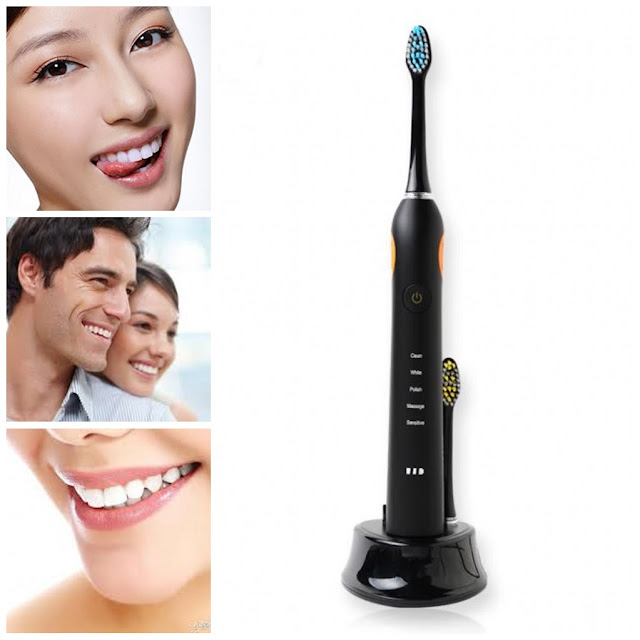It's said that electric toothbrush can remove plaque 8 times than the manual toothbrush. Today we will discuss why electric toothbrush have this strong power. Now we will take a close look to the inside center of electric toothbrush.
The cam and gear works a bit like this very simplified animation (right). The red motor is always rotating in the same direction at high speed, but the blue and black cam and crank convert that rotation into lower-speed, back-and-forth vibration. So, as the blue cam turns, the black crank pulls first one way and then the other, moving the brush head rapidly from side to side.
The cam and gear unit is connected to a gear built into the top of the motor, so the motor drives it directly. Underneath the motor, there's a rechargeable battery. Attached to the inner plastic case, there's a simple electric circuit board that controls the on/off switch on the outer case. The outer case is made of tough plastic and the on-off switch is set into it in a piece of thin, very flexible rubber. The purpose of the outer case is to keep water and toothpaste away from the circuit, motor, and battery—which would quickly rust if you got them wet. (If you're curious to know how an electric toothbrush can recharge itself standing on a plastic base, take a look at our article on induction chargers.) And that's pretty much all there is to it—a bit of clever, effective engineering technology that keeps your teeth in tip-top shape!
What is the difference between rotation electric toothbrush and sonic electric toothbrush ?
Crudely speaking, sonic toothbrushes work just like ordinary ones: they move back and forth over the surface of your teeth at high speed, scrubbing away the plaque. The most obvious difference is the speed of the movement: sonic brushes typically vibrate at about 260Hz (260 times per second), which translates into 31,000 brush strokes per minute—about 10 times faster than ordinary electric toothbrushes. As we saw up above, in a normal electric toothbrush, the very top part of the brush rotates back and forth thanks to a little cam unit just above the motor. The rest of the brush head is stationary. You can see a conventional electric brush head (actually a special one designed for cleaning the spaces in between your teeth) in the top of this photo. The removable brush head contains a little spring mechanism that lets the brush part turn back and forth, but the rest of the head remains static. With sonic toothbrushes, the entire brush head vibrates very quickly—and the manufacturers claim this produces a different type of cleaning action that makes them more effective.
According to the marketing spiel, because a sonic toothbrush buzzes over your teeth at much higher speed than a normal electric toothbrush, it not only brushes away the plaque but also creates waves of turbulence in the toothpaste and water in your mouth. Tiny bubbles form in the space between the toothbrush and the teeth, and these help to shift more plaque than brushing alone. So, when you're using a sonic toothbrush, it helps if you have quite a bit of fluid near your toothbrush. Then you can actually feel an energetic, tingling sensation around your teeth as the acoustic pressure waves created by the brush do their work. At least, that's what the makers claim.
Why it called sonic electric toothbrush ?
The bubbling cleaning action sounds similar to what happens with ultrasonic cleaning, where ultrasound (higher frequency sound than humans can hear) is used to generate pressure waves and imploding bubbles (technically called cavitation) that blast dirt off things like industrial machine parts that can be hard to clean any other way. However, as far as I can see, the resemblance between ultrasonic cleaning and what happens with a sonic toothbrush is utterly superficial. Indeed, a 2004 study of five different sonic toothbrushes by British dental researchers concluded that "cavitational activity does not occur around powered toothbrushes. Operating the toothbrushes for periods up to 20 min resulted in no cavitational activity being detected." That's hardly surprising. Ultrasonic cleaning typically uses a much higher frequency (20,000–40,000Hz) where the cavitation effect is much more pronounced. In other words, "sonic" is quite misleading—and little better than a marketing term. Ordinary (rotating head) electric toothbrushes could also be described as "sonic" inasmuch as they make a noise when they're vibrating. In both cases, it's actually the vibrating action of the brush that's doing the cleaning.
What the difference of sonic electric toothbrush inside?
Take apart a sonic brush and you'll find it's very similar to one with a rotating head, though the circuit board is typically bigger and more complex. In the sonic brush shown below, the circuit controls the brush speed (with two different speeds available at the flick of a button), a timer that beeps every 30 seconds and after two full minutes (to encourage rigorous brushing), and the battery recharging process.
Shenzhen Wufeng Technology Co.Ltd is a manufacturer and exporting company in Shenzhen China. Our main business includes adult rotation electric toothbrush, sonic electric toothbrush, kid electric toothbrush, kid battery toothbrush, toothbrush head, oral irrigation and other oral accessory. OEM order is welcome. Join us, you can find your new business opportunity .



评论
发表评论